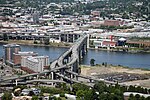Portland General Electric Company Station L Group

The Portland General Electric Company Station "L" Group in southeast Portland in the U.S. state of Oregon was a cluster of six industrial buildings listed on the National Register of Historic Places. Built between 1910 and 1929 by Portland General Electric (PGE), it was added to the register in 1985. In 1986, PGE gave Station L and 18.5 acres (7.5 ha) of land to the Oregon Museum of Science and Industry (OMSI). The Station L turbine is a central feature of OMSI's Turbine Hall. The complex was listed on the National Register in 1985, and was delisted in 2020.Station L was on the east bank of the Willamette River just south of the Marquam Bridge. The parcel of land on which the six historic one- or two-story structures rested occupied 4.7 acres (1.9 ha) of a larger property owned by PGE. All six were used to house equipment for generating electricity.Five of the listed buildings—the turbine room, the LP boiler room, the Lincoln Substation, the HP boiler room addition, and the 1929 powerhouse extension—were structurally connected. The sixth building, the Stephens Substation, was slightly northeast of the connected buildings. At the time of nomination to the National Register in 1985, the structural condition of the buildings varied from very poor to very good. Major equipment in these buildings in 1985 included an overhead crane, a turbine generator, electric switchgear, furnaces, conveyors, elevated walkways, concrete storage racks, boilers, and pipes. Taken as a whole, the group was the "last relatively complete major wood-fired steam-powered generating station in the Pacific Northwest".
Excerpt from the Wikipedia article Portland General Electric Company Station L Group (License: CC BY-SA 3.0, Authors, Images).Portland General Electric Company Station L Group
Southeast Water Avenue, Portland Hosford-Abernethy
Geographical coordinates (GPS) Address Phone number Website Nearby Places Show on map
Geographical coordinates (GPS)
| Latitude | Longitude |
|---|---|
| N 45.508718 ° | E -122.666494 ° |
Address
Oregon Museum of Science and Industry
Southeast Water Avenue 1945
97214 Portland, Hosford-Abernethy
Oregon, United States
Open on Google Maps









